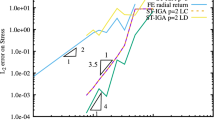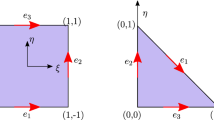Abstract
The base factors and global mesh equations corresponding to classes of basic two-dimensional problems of the elastic theory of composites are constructed in circular cylindrical coordinates (axisymmetric problems in polar coordinates). The domain occupied by the composite may be of arbitrary connectivity and configuration. The difference scheme or the global system of linear algebraic equations that corresponds to any differential problem from the given class of problems may be written explicitly
Similar content being viewed by others
REFERENCES
V. G. Golovchan, A. N. Guz, Yu. V. Kokhanenko, and V. I. Kushch, Statics of Materials, Vol. 1 of the 12-volume series The Mechanics of Composites [in Russian], Naukova Dumka, Kiev (1993).
V. G. Potemkin, MATLAB System [in Russian], Dialog MIFI, Moscow (1997).
V. M. Bystrov, “Analysis of the decay of edge effects in laminated materials on the basis of a representative element, ” Int. Appl. Mech., 36, No. 6, 826–835 (2000).
Yu. V. Kokhanenko, “Discrete models of problems in the elastic theory of composites in circular cylindrical coordinates. Three-dimensional problems, ” Int. Appl. Mech., 36, No. 8, 1067–1076 (2000).
Author information
Authors and Affiliations
Rights and permissions
About this article
Cite this article
Kokhanenko, Y.V. Discrete Models of Problems in the Elastic Theory of Composites in Cylindrical Coordinates. 2. Two-Dimensional Problems. International Applied Mechanics 37, 499–510 (2001). https://doi.org/10.1023/A:1017920415000
Issue Date:
DOI: https://doi.org/10.1023/A:1017920415000




